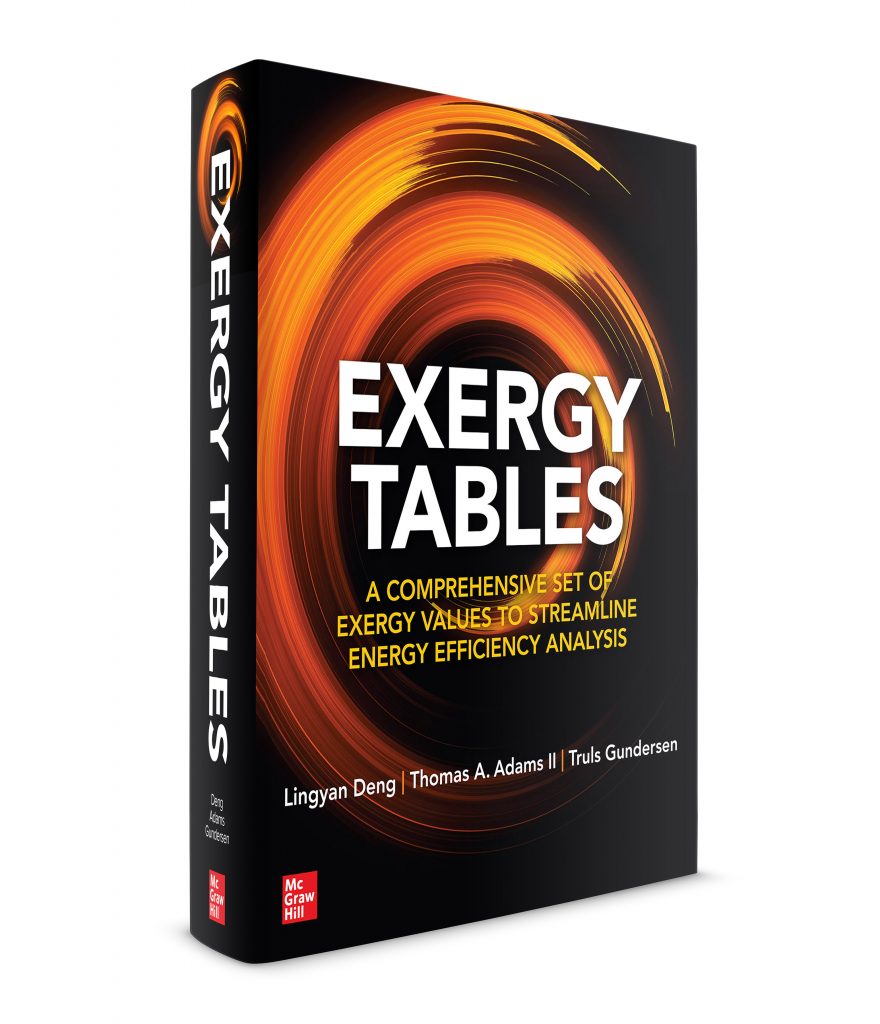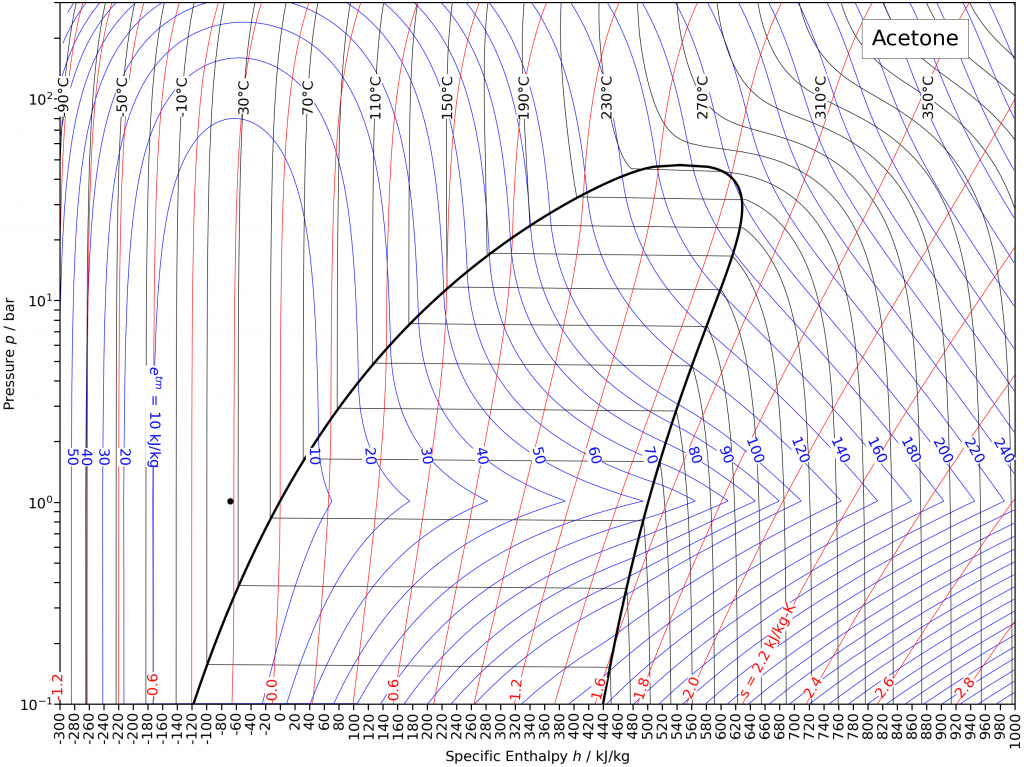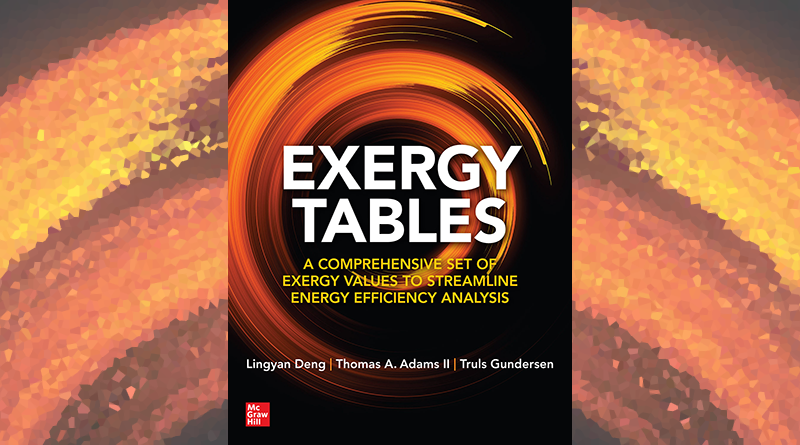Exergy Tables: A Comprehensive Set of Exergy Values to Streamline Energy Efficiency Analysis, by Lingyan Deng, Thomas A. Adams II, and Truls Gundersen (McGraw-Hill Education). Out now! [publisher link]
How to Get Exergy Tables
Digital Version: Access Engineering. Free with Subscription!. Many universities and organisations such as the American Society of Civil Engineers already have subscriptions for their students, faculty, employees, or members. Check if your university or professional organisation has a subscription today!
Print and E-Book Editions:
Worldwide: McGraw-Hill Professional
Australia: Angus and Robertson | Booktopia
Canada: Amazon | Indigo – Chapters – Coles | Kobo
Denmark: Saxo | uBuy
France: Smith and Son
Germany: Dussmann
India: Amazon
New Zealand: Fishpond
Norway: Adlibris | Ark
South Africa: Exclusive Books | Loot
Sweden: Adlibris | Bokus
UK: Amazon | Browns
USA: Apple Books | Amazon | Barns and Noble | Better World Books | Kobo | Schuler Books
Or at your favourite store by ISBN: 9781264715725
Unlock the power of Exergy Analyses Quickly and Easily
 Exergy is a fascinating topic. Using thermodynamic principles, exergy is a metric that measures both the quality and quantity of an energy source. This metric is extremely useful in chemical, mechanical, process, and many other kinds of industrial engineering fields. A practitioner can use exergy as part of a systems analysis to compute useful metrics for an energy system, such as its exergy efficiency, exergy destruction, and exergy flows.
Exergy is a fascinating topic. Using thermodynamic principles, exergy is a metric that measures both the quality and quantity of an energy source. This metric is extremely useful in chemical, mechanical, process, and many other kinds of industrial engineering fields. A practitioner can use exergy as part of a systems analysis to compute useful metrics for an energy system, such as its exergy efficiency, exergy destruction, and exergy flows.
This information is useful to understand where bottlenecks in a process might be, why a process might not be operating as efficiently as possible, and what areas to target for improvement. It is useful also for big picture decision-making, such as selecting the best processes, fuels, or unit operations for the task at hand, or whether to green light a process in the first place.
We Did the Hard Work so You Don’t Have To
That’s where Exergy Tables comes in. Exergy Tables gives you an easy way to apply this powerful tool without having worry about detailed thermodynamic theory. We have created a useful tool for the practicing engineer that makes exergy analysis much easier. The first chapter explains exergy in simple, plain language, so you can get started quickly. The second chapter provides an easy-to-follow discussion of the theory behind it and how numbers are calculated, in case you want to compute some of your own. The third chapter shows examples for how you can use Exergy Tables in your own analysis.
But it’s the rest of the book that is most useful—seven chapters of lookup tables and reference figures that contain pre-calculated exergy values for thousands of chemicals, fuels, mixtures, and process streams commonly found in the industry. We’ve defined the reference conditions, collected the necessary data, applied the theory, and compiled the results into easy-to-use tables and figures, so you can get right to the good stuff—applying exergy analysis to gain important insights into your process, investigate options, and make meaningful improvements
Pressure-Enthalpy-Exergy Diagrams
Exergy Tables contains convenient PHE diagrams not found anywhere else. Quickly find the thermo-mechanical exergy of pure chemical fluids depending on their temperature, phase, vapor fraction, enthalpy, or entropy. For example, if you know the temperature and pressure of your gas, liquid, or supercritical fluid, just plot the point on the chart and read off the thermo-mechanical exergy. No calculus, equations of state, or complex thermodynamics needed! We did that all for you!

Chemical and Thermo-mechanical Exergy Data Tables
Chemical exergy can be incredibly hard to calculate, especially for mixtures. Don’t worry though, we’ve got you covered. We’ve calculated the chemical exergies for thousands of chemicals, fuel mixtures, and common industrial process streams for you. The calculations all use a consistent set of reference conditions using the latest thermodynamic theories, so that you can easily combine numbers from throughout the book together in the same analysis. (If you cherry pick numbers from one source to the next that were computed with different reference conditions, you’ll get the wrong answers!). Just look up the chemical or mixture you care about, find the chemical exergy, and get right to the good stuff!

Special Features:
- Exergy for any engineer! We make it easy. No calculus needed!
- All the data you need in one place.
- First of a kind pressure-enthalpy-exergy diagrams provide useful information and visual insights
- Plain language and easy to follow examples of Exergy Analyses
- Chemical exergy values for 1000s of pure chemicals, process gases, liquid fuel mixtures, heterogeneous solid fuels, and more.
- Thermo-mechanical exergy values of common pure chemicals at wide ranges of temperatures and pressures in liquid, gas, two phase, and supercritical regions
- All data computed with consistent and up-to-date reference conditions
- Learn how to easily compute the thermodynamic limits (best possible performance) for your process
- Eliminate bottlenecks and use energy in the best way
- Unlock the potential of exergy analysis by eliminating the most common barriers
- A great compliment to your reference library!
Table of Contents
| Title | Summary | |
|---|---|---|
| Preface | Preface | What the book is about. |
| Chapter 1 | Introduction | Simple exergy explanation in plain language |
| Chapter 2 | Exergy from Thermodynamics | The theory behind the numbers |
| Chapter 3 | Using Exergy Data in Analyses | How to perform exergy analyses using the book, with lots of examples. |
| Chapter 4 | Reference Conditions | The reference conditions used in the book. Exergy of reference chemicals in the air, sea, and earth's crust. |
| Chapter 5 | Air | Chemical and thermo-mechanical exergies of gases in the atmosphere. |
| Chapter 6 | Water | Chemical and thermo-mechanical exergies of water and heavy water |
| Chapter 7 | Pure Chemicals | Chemical and thermo-mechanical exergies of pure chemicals |
| Chapter 8 | Gas Mixtures | Chemical and thermo-mechanical exergies of common gas mixtures (process streams and fuels) |
| Chapter 9 | Liquid Mixtures | Chemical and thermo-mechanical exergies of various liquid fuel blends |
| Chapter 10 | Solid Fuels | Chemical and thermo-mechanical exergies of heterogeneous solid fuels (coals, biomasses, wastes, etc) |
Example Files
The Aspen Plus simulation files used in the book are available the LAPSE repository at the link below. You don’t need to know or use Aspen Plus to do exergy analyses. These are simply examples.
If you are interested in Aspen Plus though, check out Learn Aspen Plus in 24 Hours.

